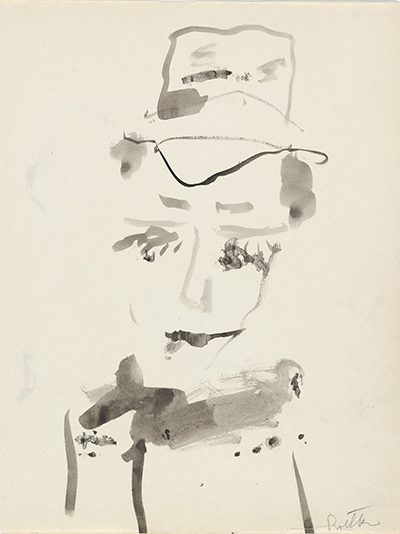Barnett Newman
Mark Rothko painted a mosaic image of his friend and fellow painter Barnett Newman in 1949. Newman's artworks were an inspiration to Mark Rothko and helped Mark mature his art pieces in New York. Barnett Newman was also a member of the Uptown Grown that Mark Rothko also joined. Together, they presented several works in various New York exhibitions in the 1940s. Their friendship grew tremendously such that Mark drew an image of his friend in 1949.
This image is a scribbled outline of a gentleman in black ink on a grey canvas. It is more of a drawing than a painting as the painter shows the outline of the figure and no colouring in the context. The drawing shows a man wearing a round hat with the visor partly covering his face. The outline of his hair is visible from the sides of the hat. The eyes seem to have been partially closed, and he wears a rounded collar shirt. The painting is simple. While not to the scale, the image is pretty accurate in terms of Barnett Newman's features and general proportions for a human portrait.
Style of the Painting
This image is a combination of minimalist art and surrealism art. Despite minimalism not having taken root in the USA (it did in the early 1960s), Mark had already incorporated parts of minimalist style in creating his friend Barnett's drawing. Minimalism is an extreme form of abstract art where artworks were composed of simple shapes made of just lines.
At this time, minimalist styles were not well developed, and the artist used conventional lines rather than geometric shapes. Nevertheless, he gives a good outline of his artist friend's features such that they are recognizable to any viewer looking at the image. It was easy for him to go minimalist as he had already tried the abstract style of art.
On the other hand, this image incorporates elements of surrealism style. With surrealism, artists allowed their subconscious minds to make decisions of images to appear on the canvas. This artistic touch of his brain's imagination creates a unique image, and the artist does not make any attempt to straighten parts of the body that seems out of shape. This is a perfect example of surrealism.
This painting is a little different from most of the pieces that Mark Rothko did in his lifetime. He loved to play with colours and often used contrast to show dynamism. However, he loved to experiment with different styles and try new ideas different from his usual style. This is one of a kind and came out so good.

